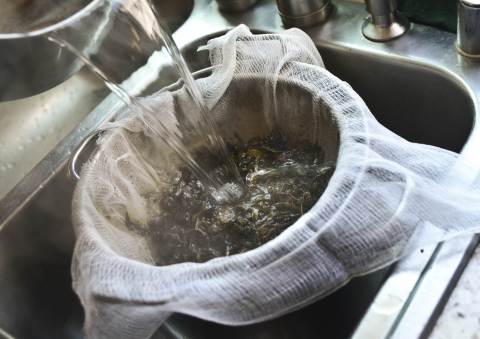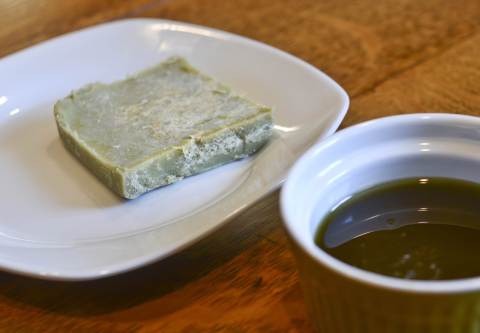How to make cannabutter and oil like a pro
Uncategorized January 17, 2020 MJ Shareholders

When it comes to marijuana edibles, brownies and baked goods get all the attention.
But there’s no reason both medical marijuana patients and recreational consumers who don’t want to smoke their cannabis can’t get their daily dose from healthier foods, like salad dressing or stir-fried shrimp. They just need to know the right way to infuse those savory dishes with marijuana by mastering the basics of making cannabis butter or oil.
Enter chef, author and activist Cheri Sicard, better known as Cannabis Cheri.
“When a consumer can make their own marijuana edibles, they can really customize it for what they need,” Sicard said. “Definitely one size does not fit all.”
The Long Beach resident started off as an entertainer, traveling the world as a circus performer and magician. While on the road, she developed a passion for writing and for food, soon founding the recipe website FabulousFoods.com and authoring several books on cooking and citizenship.
It wasn’t until her late 30s that Sicard began using these talents in the cannabis world, after a doctor quietly recommended she try marijuana to ease a nausea problem other medications weren’t curing. She was hesitant at first, with “reefer madness” swirling in her mind.
“I really worried that I was doing myself harm even though it was alleviating symptoms,” Sicard said. “What I found was everything I was told was a lie.”
Within six months, Sicard became an outspoken advocate for the benefits of cannabis. She now regularly speaks at local events with the Orange County chapter of NORML. She is also founder of the nonprofit organization Marijuana Lifer Project, which goes to bat for nonviolent federal offenders serving life sentences for marijuana.
Sicard has written two books on her favorite plant: “Mary Jane: The Complete Marijuana Handbook for Women” and “The Cannabis Gourmet Cookbook.”
Before trying marijuana-infused foods, Sicard recommends newbies start with smoking or vaping until they learn how they react.
“It’s very easy to get too much with an edible if you don’t know what you’re eating,” she said.
While a strong dose doesn’t pose any serious health risks, she said, it can make people disoriented or paranoid, giving them a bad experience that can scare them off from marijuana altogether.
When trying edibles, Sicard recommends people start with a small taste. And if they don’t feel the effect they wanted, she advises sleeping it off, waiting until the next day and trying a slightly larger dose.
There are many ways to infuse foods with marijuana, such as adding concentrates or even the leaves themselves to hearty dishes like meatballs. But THC, the psychoactive compound in marijuana, is fat-soluble. That means it dissolves and metabolizes best in fatty foods, Sicard said, which makes butter and oil the perfect vehicles.
Making cannabis butter and oil is also a pretty simple process, with only a few kitchen gadgets required. It’s economical, since it can be made with the marijuana trimmings home-growers would likely otherwise throw away. And it presents lots of cooking options, since you can essentially swap out regular butter or oil with cannabis-infused products in just about any recipe.
Sicard’s recipe is unique because it includes water. That helps ensure the cannabis never boils, she said, which can destroy the THC, with overcooking a rookie cannabis cook mistake. Also, the water will help strip out some of the plant’s herbal flavor and green color, she said, which aren’t typically desirable in edibles.
Here are Sicard’s directions for making one cup of cannabis-infused butter or oil.
Ingredients:
- 1 1/4 cups unsalted butter OR 1 1/4 cups cooking oil (olive, vegetable, canola, corn, peanut or grape seed oil all work)
- 1 ounce average- to high-quality trim or low-quality dried bud OR 1/2 ounce average-quality dried bud
- 4 cups water
Cooking directions:
Slow cooker method – Add ingredients to the slow cooker and cook on low for four to six hours.
Stove top method – Place ingredients in a large, lidded Dutch oven on the stove top. Bring to a boil, then reduce heat to very low and simmer for about two hours. Monitor the liquid level often, adding water as needed to keep at least three cups in the pot.
Drain, Rinse and Strain:
Place a cheesecloth-lined strainer over a large bowl and strain the liquid. Then pour a large kettle of boiling water over the full strainer to wash through any extra butter or oil clinging to the plant material. Allow the plant material to cool, then squeeze out as much liquid as possible before throwing it away.

Next, chill the water and oil or liquid butter, allowing the fats to rise to the top.
The butter will harden into a solid, making it easy to scoop from the water below. Rinse the butter chunk with cold water to wash away any leftover plant material.
Oil will rise to the top of the water but often won’t solidify. You can use a spoon to skim the oil off the water. Even better is a gadget called a gravy separator, which is a small pitcher of sorts that allows the water to be poured out while retaining the oil floating at the top.
Now strain the butter or oil one more time to remove as much sediment as possible. For the oil, pour it through a double layer of cheesecloth again. To strain butter a second time, melt it, strain it through the cheesecloth, then chill it until it’s solid again.
Bonus cooking tips from Cannabis Cheri
Save your money: “There’s no reason for you to cook with top-shelf weed,” chef and author Cheri Sicard said. While high-quality product can be smoother to smoke, she said it doesn’t make a difference in cooking. The only thing to pay attention to is potency.
Don’t grind it: While some recipes or guides advise using a coffee grinder or food processor to finely grind weed before cooking with it, Sicard advises against that. “What you’re trying to extract is on the leafs, not in them,” she said. So if you grind it up too finely, she said, you’ll simply get more herbal flavor and green color in your food.
Mask the smell: Simmering marijuana on the stove top will produce strong smells. To mask the odor, cook other potent foods like garlic at the same time. Better yet, Sicard said, use a slow cooker. Her favorite is Hamilton Beach’s Stay and Go, which has a clamping lid.
Season away: Since the herbal flavor of cannabis can still shine through in foods, Sicard recommends making savory dishes with lots of seasoning rather than delicate desserts. Find dozens of recipes on her website, CannabisCheri.com, or in her book “The Cannabis Gourmet Cookbook.”
Store it: Refrigerate infused butter or oil until you’re ready to use it. You can also freeze it for up to three months.

Editors note: This article has been refreshed due to reader interest.
MJ Shareholders
MJShareholders.com is the largest dedicated financial network and leading corporate communications firm serving the legal cannabis industry. Our network aims to connect public marijuana companies with these focused cannabis audiences across the US and Canada that are critical for growth: Short and long term cannabis investors Active funding sources Mainstream media Business leaders Cannabis consumers








